3、springboot:springboot配置文件(配置文件、YAML、属性文件值注入<@Value、@ConfigurationProperties、@PropertySource,@ImportResource、@Bean>)
1.配置文件:
配置文件有两种(开头均是application,主要是文件的后缀):
作用:修改springboot自动配置的默认值
位置:
配置文件放在src/main/resources目录或者 类路径/config 下
2.YAML:
YAML(YAML Ain't Markup Language)
YAML A Markup Language:是一个标记语言
YAML isn't Markup Language:不是一个标记语言;
标记语言:
以前的配置文件;大多都使用的是 xxxx.xml文件;
YAML:以数据为中心,比json、xml等更适合做配置文件;
该语法风格:
server:
port: 8088
使用语法:
k:(空格)v:表示一对键值对(空格必须有);
以空格的缩进来控制层级关系;只要是左对齐的一列数据,都是同一个层级的
值的写法:
字面量:普通的值(数字,字符串,布尔)
k: v:字面直接来写;
字符串默认不用加上单引号或者双引号;
" ":双引号;不会转义字符串里面的特殊字符;特殊字符会作为本身想表示的意思
name: "zhangsan \n lisi":输出;zhangsan 换行 lisi
' ':单引号;会转义特殊字符,特殊字符最终只是一个普通的字符串数据
name: ‘zhangsan \n
1.对象、Map(属性和值)(键值对):
注意空格
Person:
name:(空格)张三
age:(空格)12
行内写法:
Person: {name:xxx,age=12}
2.数组(List、Set):
用-(空格)值表示数组中的一个元素
gender: - boy - gril
行内写法
gender: [gril,boy]
导入配置文件处理器,配置文件进行绑定就会有提示
<dependency>
<groupId>org.springframework.boot</groupId>
<artifactId>spring-boot-configuration-processor</artifactId>
<optional>true</optional>
</dependency>
3.代码测试
/** * 将配置文件中配置的每一个属性的值,映射到这个组件中 * @ConfigurationProperties:告诉SpringBoot将本类中的所有属性和配置文件中相关的配置进行绑定 * prefix = "person";配置文件中哪个下面的所有属性进行一一映射 * * 只有这个组件在容器中,才能获得容器提供的@ConfigurationProperties功能; * @ConfigurationProperties(prefix = "person")默认从全局配置中获取值 */ @Component @ConfigurationProperties(prefix = "person") public class Person { private String name; private Integer age; private boolean boss;//布尔值 private Date bir;//时间 private Map<String,Object> map;//Map private List<String> lists;//List private Dog dog;//对象 }
public class Dog { private String name; private Integer age; }
在yml配置文件中
person: name: Mr age: 14 boss: true bir: 2018/12/21 map: {m1: v1,m2: v2} lists: - mc - mt dog: name: dogdog age: 10
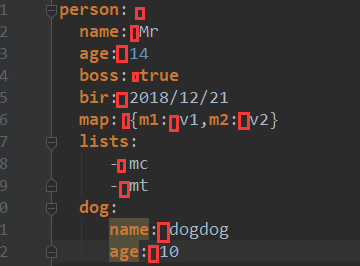
测试:
@RunWith(SpringRunner.class) @SpringBootTest public class Springboot01ApplicationTests { @Autowired Person person; @Test public void contextLoads() { System.out.println(person); } }
输出
Person{name='Mr', age=14, boss=true, bir=Fri Dec 21 00:00:00 CST 2018, map={m1=v1, m2=v2},
lists=[mc, mt], dog=Dog{name='dogdog', age=10}}
使用properties后缀的:
application.properties
person.name=mr person.age=22 person.bir=2018/12/11 person.boss=true person.map.q1=1 person.map.q2=2 person.lists=a,b,c person.dog.name=cat person.dog.age=22
关于乱码的问题:
properties配置文件在idea中默认utf-8可能会乱码
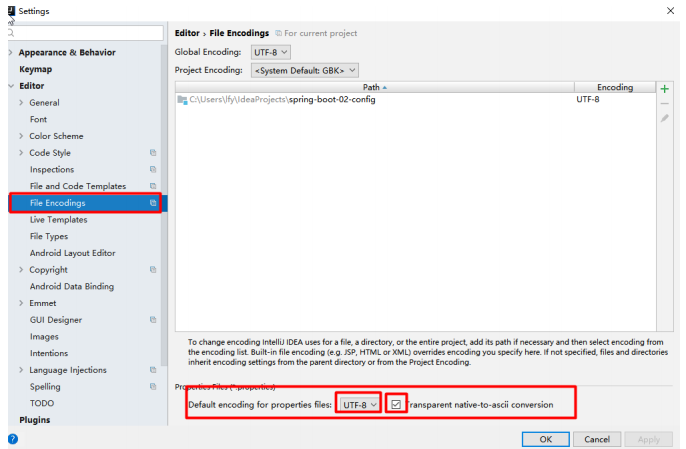
4.配置文件值注入@Value
@Value:1.字面量 2.#{spel} 3.${key}从环境变量配置文件中取值
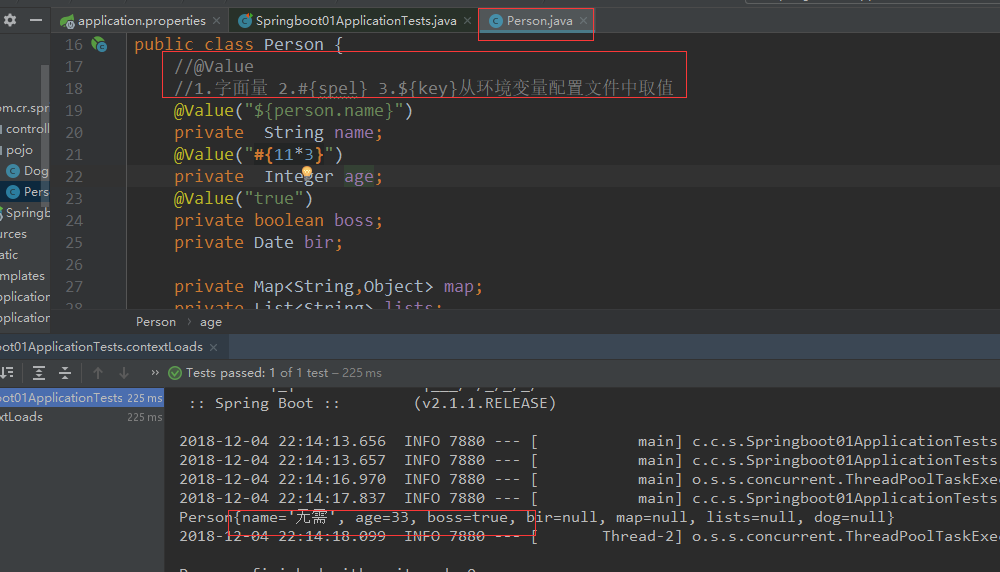
@Value获取值和@ConfigurationProperties获取值比较
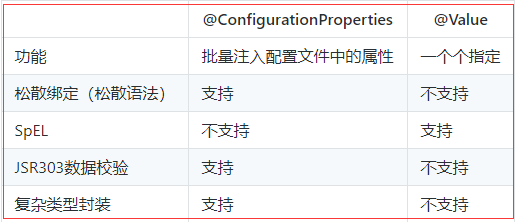
松散语法绑定:last_name = last-name = lastName 他们取的值都是相同的
配置文件yml还是properties他们都能获取到值;
如果说,我们只是在某个业务逻辑中需要获取一下配置文件中的某项值,使用@Value;
如果说,我们专门编写了一个javaBean来和配置文件进行映射,我们就直接使用@ConfigurationProperties;
数据校验:
@Component @ConfigurationProperties(prefix = "person") @Validated public class Person { @Email private String name; ... }
获取配置文件中的某个值:
@ResponseBody @Controller public class Helloword { @Value("${person.name}") private String name; @RequestMapping("/hello") public String hello(){ return "Hello tow!" + name; } }
5.@PropertySource,@ImportResource
@PropertySource(value = {"classpath:/person.properties"})
@Component
@ConfigurationProperties(prefix = "person")
public class Person {
private String name;
private Integer age;
private boolean boss;
private Date bir;
...
}

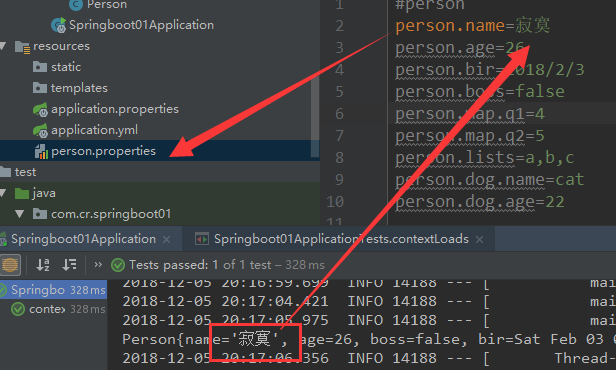
@ImportResource
@ImportResource:导入Spring的配置文件,让配置文件里面的内容生效;
Spring Boot里面没有Spring的配置文件,我们自己编写的配置文件,也不能自动识别;
想让Spring的配置文件生效,加载进来;@ImportResource标注在一个配置类上
@ImportResource(locations = {"classpath:spring.xml"})
@SpringBootApplication
public class Springboot01Application {
public static void main(String[] args) {
SpringApplication.run(Springboot01Application.class, args);
}
}
public class helloword { public void hello(){ System.out.println("hello"); } }

<?xml version="1.0" encoding="UTF-8"?> <beans xmlns="http://www.springframework.org/schema/beans" xmlns:xsi="http://www.w3.org/2001/XMLSchema-instance" xsi:schemaLocation="http://www.springframework.org/schema/beans http://www.springframework.org/schema/beans/spring-beans.xsd"> <bean id="hello" class="com.cr.springboot01.ImportSoource.helloword"></bean> </beans>
@Autowired ApplicationContext app; @Test public void testImportSourcr(){ boolean h = app.containsBean("hello"); System.out.println(h); }

@Bean
全注解方式:
新建一个配置类
//配置类,指明当前类使配置类,代替xml配置文件 @Configuration public class MyConfig { //将方法的返回值添加到容器中,容器中这个组件默认的id就是方法名 @Bean public Helloword hello(){ System.out.println("注解的方式"); return new Helloword(); } }
@Autowired ApplicationContext app; @Test public void testImportSourcr(){ boolean h = app.containsBean("hello"); System.out.println(h); }







【推荐】国内首个AI IDE,深度理解中文开发场景,立即下载体验Trae
【推荐】编程新体验,更懂你的AI,立即体验豆包MarsCode编程助手
【推荐】抖音旗下AI助手豆包,你的智能百科全书,全免费不限次数
【推荐】轻量又高性能的 SSH 工具 IShell:AI 加持,快人一步
· AI与.NET技术实操系列:向量存储与相似性搜索在 .NET 中的实现
· 基于Microsoft.Extensions.AI核心库实现RAG应用
· Linux系列:如何用heaptrack跟踪.NET程序的非托管内存泄露
· 开发者必知的日志记录最佳实践
· SQL Server 2025 AI相关能力初探
· winform 绘制太阳,地球,月球 运作规律
· AI与.NET技术实操系列(五):向量存储与相似性搜索在 .NET 中的实现
· 超详细:普通电脑也行Windows部署deepseek R1训练数据并当服务器共享给他人
· 【硬核科普】Trae如何「偷看」你的代码?零基础破解AI编程运行原理
· 上周热点回顾(3.3-3.9)